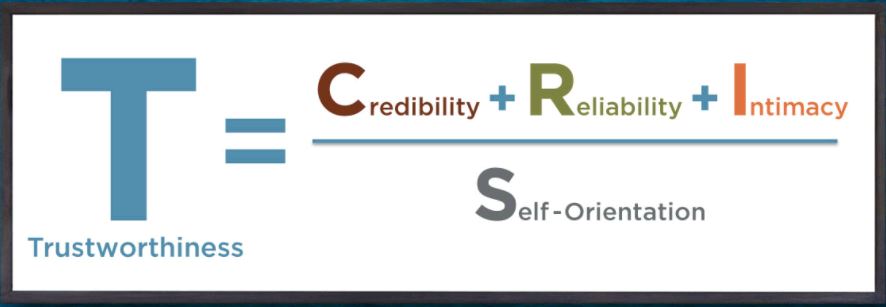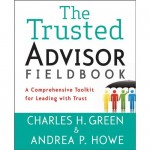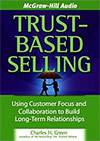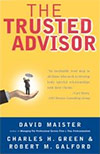The basic elements of trustworthiness are contained in the Trust Equation.

T stands for Trustworthiness—how much the buyer/client trusts the seller, or consultant.
C is Credibility—it speaks to words. Can we be believed, based on our credentials and truthfulness?
R is Reliability—it speaks to the consistency of actions. Do we meet expectations, and do our actions reflect our words (integrity)?
I is Intimacy—it speaks to the security or safety a client feels. Do we connect with and understand them? Do they feel safe sharing information with us?
S is Self-Orientation, the lone term in the denominator, and it has a double meaning. Partly it’s about selfishness. Are we client-centric for the sake of the client? Or client-centric like a vulture?
But Self-orientation is also about our attention, our focus. Are we listening just to get data to pursue our own hypotheses and ends? Or are we listening to truly hear the client? Are we obsessed by our own desires to succeed or win, and by our insecurities? Or do we truly focus on the client, paying attention to whatever it is that helps them succeed, or makes them insecure? Only the latter builds deep, long-term relationships.
High numerator scores build trust: a high score in self-orientation destroys it.
Most of us lead with the first two factors—credibility and reliability. These are quantifiable, and “rational.” Consultants overrate these as the “obvious” virtues—so do clients. Clients aren’t comfortable “confessing” that they have feelings, intuitions, instincts and chemistry. They don’t want to reject someone based on “we just didn’t have a good feeling for you.”
But most humans—including clients—buy from the heart, and justify it from the head. That means the Intimacy and the Self-Orientation factors are very powerful in buying.
Rational thinking (including C and R) is about defining benefits and payoffs. But any expected value must be discounted by the client’s confidence that they’ll get the results promised. The I and S factors speak to this. Can I collaborate and be honest with this person—and he with me? Does she actually care about me and my company, or are we just means to her ends? The I and S factors in the trust equation represent the non-rational impact that every client applies to their estimation of stated benefits to calculate their true net expected value.
Watch Video: Charles Green on Trust Equation
The trust equation reflects the human balance of mind and heart. Together, it creates powerful economics. Many con-men are credible, and sharks are reliably shark-like. But if we get a sense that a seller understands and appreciates us—and that they seem to have our better interests at heart—then we allow their intelligence and dependability to be of service to us.
The economics of repeat business are massively lower costs, and higher value, for both trustor and trustee. Relationships are built not on one-off transactions, but on longer term commitments by each to the success of the other. It’s this commitment to the other that paradoxically creates more value for each. Relationships trump transactions, with trust at the heart of the matter.
For continued reading check out: The Trust Quotient and the Science Behind It
Talk To Us
THE TRUSTED ADVISOR FIELDBOOK
 The pragmatic, field-oriented follow-on to the classic The Trusted Advisor. Green and Howe go deep into the how-to’s of trusted business relationships—loaded with stories, exercises, tips and tricks, and deeply practical advice.
The pragmatic, field-oriented follow-on to the classic The Trusted Advisor. Green and Howe go deep into the how-to’s of trusted business relationships—loaded with stories, exercises, tips and tricks, and deeply practical advice.
FIND OUT MORE
TRUST-BASED SELLING
 “Sales” and “Trust” rarely inhabit the same sentence. Customers fear being “sold” — they suspect sellers have only their own interests at heart. Is this a built-in conflict? Or can sellers serve buyers’ interests and their own as well? The solution is simple to state, hard to live—and totally worth the effort.
“Sales” and “Trust” rarely inhabit the same sentence. Customers fear being “sold” — they suspect sellers have only their own interests at heart. Is this a built-in conflict? Or can sellers serve buyers’ interests and their own as well? The solution is simple to state, hard to live—and totally worth the effort.

